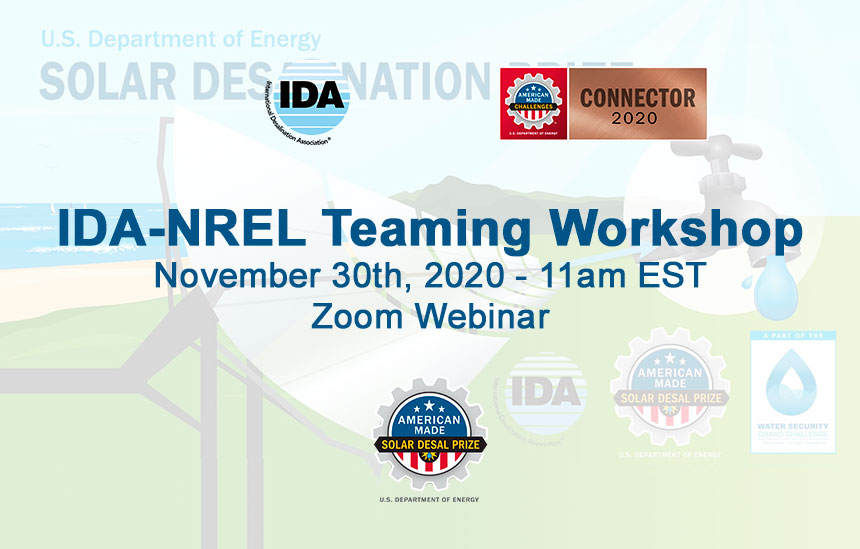October 29, 2020, Boston, MA – The International Desalination and Reuse Association (IDRA) is teaming up with the U.S. Department of Energy (DOE) and their National Renewable Energy Laboratory (NREL) to support quarter finalist teams in the $9 million Solar Desalination Prize competition.
The American-Made Challenges: Solar Desalination Prize is a four-stage competition, designed to accelerate the development of low-cost desalination systems that use solar-thermal power to produce clean water from saltwater.
Competitors receive cash prizes as they advance through each stage of the competition, culminating in a $1 million grand prize for the successful testing and demonstration of a promising solar-thermal desalination system prototype.
On Oct. 19, DOE announced the quarter-finalist winners, which included 19 teams from 12 states. The announcement coincided with the start of the teaming phase, which challenges the Innovation Phase contest winners to build teams.
“We’ve seen significant interest in the competition since it was announced and were pleased with the high number of quality submissions, we’re excited to work with IDRA on the next phase” said Sarah Gomach, American-Made Challenges Prize Administrator at NREL.
On Nov. 30, IDRA will host a Teaming Webinar for individuals, companies, test sites, and related organizations interested in joining the team of an Innovation Phase winner, to take the preliminary concept into a fully operational prototype.
Each of the 19 Innovation Phase winners will make a short pitch about their project during the event. There will be one speaker per team. Those interested in partnering with a team will receive contact information upon registration to the event. Competitors can leverage industry expertise, access private capital, and obtain mentorship and support through the American-Made Network, a group of national laboratories, incubators, investors, and industry experts. The Network also provides access to local capabilities that will help accelerate the development of their desalination system prototypes.
“The IDRA has committed to advocating H20 minus C02 solutions to reduce the C02 footprint in desalination by incorporating renewable energy to power both large and small scale systems. We proudly endorse the DOE and NREL Solar Desalination Prize and look forward to presenting the teaming workshop,” said Shannon McCarthy, IDRA Secretary General.
The teams are:
1. Heat Storage for 24-Hour Solar Desalination
Location: Arcadia, CA
Project Summary: Element 16 is a small company developing a sulfur-based thermal energy storage (TES) technology to generate low-pressure steam for desalination. Sulfur has a low melting point (105° Celsius) and low cost ($80/ton). By using lower-cost containment materials, this project aims to reduce sulfur TES cost to below $15/per kilowatt-thermal and reduce heat-exchanger costs, to attain a levelized cost of water below $0.50 per cubic meter (m3).
2. Solar Thermal Enhanced Evaporation
Location: Minneapolis, MN
Project Summary: Researchers from the University of Minnesota propose a humidification-dehumidification desalination system that will handle small-volume brine from industrial facilities that do work such as electroplating, which coats metal onto surfaces, dyeing, and mining. This project will use large fans, evaporators, and heat-pump-driven condensation systems to manage brine mixed with industrial metals. The team plans to industrially source forced-flow evaporators and fans to attain a levelized cost of water no higher than $1/m3.
3. NoAir: Super-Vacuum Gap NanoMembrane Distillation
Location: Gainesville, FL
Project Summary: This team, led by the small company Focused Sun, proposes a linear Fresnel solar-collector system that will generate steam for a process called thermal vapor compression (TVC) to provide pumping power for the system. The brine will be preheated by a membrane desalination (MD) system, which is then fed with brine from the TVC system to further desalt and recover water. This MD-TVC system could attain high energy efficiency at low pressure and be used to treat water produced from oil and gas extraction, with no electricity input.
4. TSSE Desalination of Hypersaline Brines
Location: Santa Barbara, CA
Project Summary: A Columbia University–led team proposes a desalination technique using a solvent that, when heated, attracts brine in high-salinity water, separating it from fresh water. Increasing the temperature of the feedwater will cause the clean water to float above the solvent, enabling reuse of the solvent in subsequent cycles. This method has the potential to be highly thermally efficient because it does not require evaporation and condensation, unlike in conventional desalination systems.
5. Sorption-Based ZLD Technology
Location: Houghton, MI
Project Summary: A team of researchers from Oak Ridge National Laboratory, Michigan Technological University, and the company Artic Solar proposes to add an adsorption-desorption system to a multiple-effect desalination system (MED) to achieve zero liquid discharge (ZLD). They have identified a liquid that could extract all the water-vapor volume from the brine slurry of a MED system, thus enabling an energy-efficient, modular ZLD treatment
6. Portable Treatment of Oil/Gas Wastewater with ZLD
Location: Corvallis, OR
Project Summary: A team of researchers from Oregon State University and Michigan State University plans to advance a humidification-dehumidification process that can recover clean water from water produced by oil and gas extraction. A novel cyclone separator, which can be easily designed at small scale for portability, separates salt from humid air and enables the process. By separating humid air from solid salt particles, this technology could be a cost-effective method to achieve zero-liquid discharge (ZLD). The team intends to demonstrate their system with real produced-water brines integrated with solar-thermal energy and scaled up to 250 kilograms per hour.
7. Forward Osmosis – Biomimicry at Work
Location: Rohnert Park, CA
Project Summary: This team of researchers from the Natural Energy Laboratory of Hawaii and Trevi Systems, a small company developing novel forward osmosis (FO) desalination technology, proposes to build a 500 m3/day FO system with solar collectors as a heat source. The team will advance its FO draw solution by significantly increasing throughput and lowering the system’s energy requirements.
8. STREED – Resonant Energy Exchange Desalination
Location: Houston, TX
Project Summary: A team led by researchers from Rice University has developed prototypes of a nanoparticle-based high-efficiency, low-maintenance solar-heated membrane distillation technology. The team plans to develop a commercializable system design that uses spiral-wound architecture to minimize the plant’s physical footprint.
9. Zero Discharge Multi-effect Adsorption Distiller
Location: Trenton, NJ
Project Summary: GreenBlu will develop a full-plant prototype of a zero-liquid discharge solar-thermal desalination system with mineral recovery using its multi-effect adsorption distillation technology. The concept has the potential to be much more thermally efficient, and require simpler operation and maintenance, relative to conventional distillation technology.
10. Modular Inexpensive Solar-Thermal Evaporative Desal
Location: Andover, MA
Project Summary: Physical Sciences, Inc. proposes to integrate a low-concentration solar receiver with a multistage flash evaporator in one device to reduce capital cost. The evaporator efficiently distills water by combining numerous distillation stages so that each one uses the heat output from the previous stage. The evaporator operates at low temperature, which allows the use of low-cost cylindrical optics. The team intends to build a 20-stage multistage flash device inside a cylindrical tube receiver to produce 100 m3/day of desalinated water.
11. Solar Aqua Flex: Off-Grid Solar Still
Location: Nashville, TN
Project Summary: This team, led by researchers from Vanderbilt University, will develop a multistage membrane distillation system made of floating, flexible, layered “mats” to desalinate water. The mat has a nonporous, heat-absorbing top layer; a water layer that evaporates; a distillate layer where the vapor ends up after moving through a membrane to condense; a feedwater layer; and a conductive layer that heats the feedwater. This concept has the potential to be modular and portable, with higher production than similar existing systems.
12. Brine Concentration with Managed Salt Precipitates
Location: Hopewell, NJ
Project Summary: This team, led by AIL Research, has proposed a membrane desalination system capable of handling very-high-salinity water and using recovered heat to preheat the brine feed. The membrane will not have to be corrosion-resistant because readily precipitating ions, such as magnesium and calcium, can supersaturate and crystallize in a brine tank above the membrane. Managing the precipitation of salt and using recovered heat allows more water recovery from high-salinity brines.
13. Urban Solar-Desal Building
Location: College Park, MD
Project Summary: A team led by the University of Maryland’s Center for Energy Environmental Engineering will develop a vertical, building-integrated desalination system for urban areas. Solar-thermal collectors will be the energy source to heat multistage vacuum membranes in the system. This concept has the potential to decentralize desalination at the point of use.
14. Membrane Distillation with Ceramic Membranes
Location: Storrs, CT
Project Summary: This team, led by researchers from the University of Connecticut, will integrate a SETO-funded, newly developed ceramic membrane technology with a solar collector system to treat high-salinity or chemically complex brines. The ceramic membranes provide thermal and chemical stability that enable them to process challenging saline waters.
15. Mimicking Rain Cycle Using Traveling Liquid Beads
Location: Los Angeles, CA
Project Summary: This team, led by researchers from the University of California, Los Angeles, is developing a humidification-dehumidification process that lowers the cost of manufacturing high-surface-area components. By using low-cost polymer string architectures in the dehumidification process, the team expects cost-effective, energy-efficient desalination of high-salinity water.
16. Switchable Solvent Water Extraction from Brine
Location: Rohnert Park, CA
Project Summary: A team including researchers from Idaho National Laboratory and Trevi Systems is developing a solar-thermal-powered liquid/liquid extraction process that removes “hard” ions, like calcium and magnesium, in brine fed to reverse osmosis, a conventional desalination process. This method could improve the efficiency of reverse osmosis by allowing the process to operate over wider brine input conditions and requiring less maintenance to remove the scale caused by hard ions.
17. X-VAP: Self-Contained Distillation
Location: Houston, TX
Project Summary: Katz Water Technologies is redesigning its self-contained, compact distillation system to use solar-thermal energy instead of natural gas. The system distills and separates purified water in a closed-loop heat exchanger. The technology has the potential to be a modular, portable system that can supply fresh water where needed.
18. CCR’s LTDis Technology
Location: Frisco, TX
Project Summary: Crystal Clearwater Resources is developing its “LTDis” evaporator technology, which can use solar heat to treat challenging waste streams and achieve zero liquid discharge. The concept uses a spray-based evaporation and condensation chamber to replace the stages with tubes (surfaces used for condensation and evaporation) in conventional multiple-effect desalination plants. Direct evaporation and condensation of sprays in vacuum chambers eliminate corrosion concerns and reduce the size and cost of vessels.
19. 100% Solar Transcritical Water Desalination
Location: Pittsburgh, PA
Project Summary: Epiphany Solar Water Systems has developed a water desalination and crystallizer unit that uses solar-thermal energy to desalinate water by increasing the temperature and pressure sufficiently to cause water to transition to a supercritical phase, in which salt does not dissolve. The fully integrated system will use solar collectors to provide heat, heat recovery from the supercritical water distillate to improve efficiency, and crystallizers to separate salts from the distillate. This technology has the potential to be more thermally efficient than conventional distillation techniques.
The Teaming Webinar will take place on November 30, 2020 at 11 am EST, there is no charge for this webinar, to register and receive contact information of the teams, please visit https://events.eply.com/IDANRELTeamingWorkshop
About IDRA
The International Desalination and Reuse Association (www.idadesal.org) has been operating as a US non-profit organization for over 45 years. It serves as a leading point of connection for the global desalination, water reuse, and renewable energy sectors. IDA serves members in 60 countries and reaches an additional 4,000 affiliate members. IDRA is associated with the United Nations as part of a growing international network of non-governmental organizations (NGOs).


